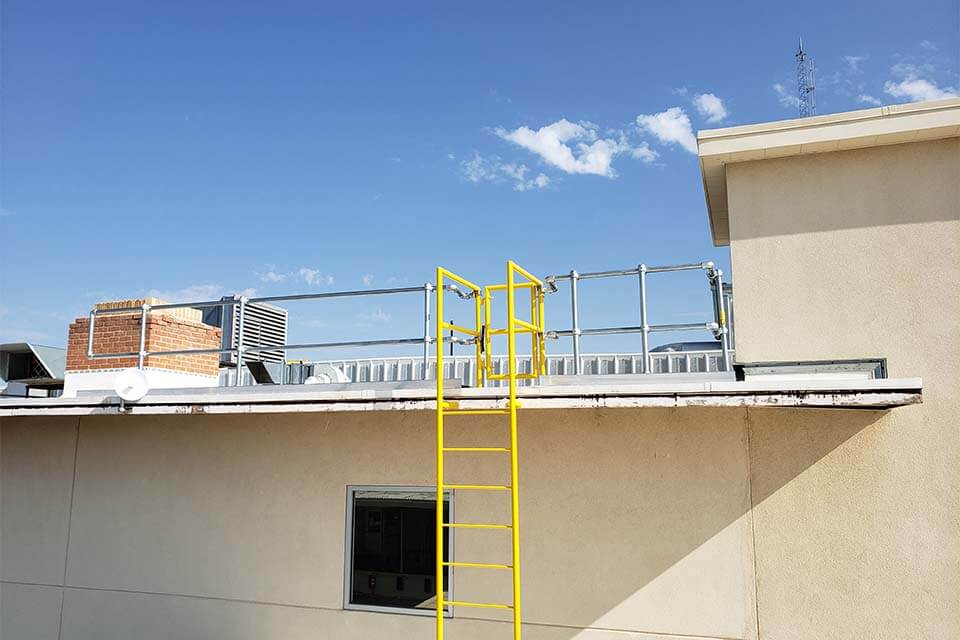How to Secure Rooftop Access Points

Working on a roof is inherently dangerous work, but the dangers aren’t only present during the work. Accessing the roof in the first place presents its own set of hazards.
Ladders are one of the most common methods of access and there is a reason they get their own section of the OSHA standards. Staircases are generally safer, but they don’t come without their own issues. As with everything else, you need to review your specific set of circumstances to determine what needs to be done to protect your employees.
So where do you begin?
Access Location
Before we even get to the hazards that exist with specific types of access, it’s important to understand that not all architects and engineers have safety in mind when designing their buildings. While one might think it’s a no-brainer to not put roof access in a dangerous location, many buildings have roof hatches or stairwell doors that open up right to the edge of the roof.
Unless a railing is in place – and, often, it is not – your employees or contractors are in immediate danger. If this is the case with your building, you should waste no time installing some sort of protection.
But placement hazards don’t end there. It would not be unusual, unfortunately, to discover that your roof access ladder is located in a busy production area or a place where forklift traffic is heavy. Don’t forget, even when architects and engineers did their best to place access out of the way, they often don’t know what operations will be taking place in the building or what the logistics of those operations are going to be.
And, operations change.
What could have started out with a safe setup, could have changed when somebody made a bad decision to store hazardous or flammable materials near your access. The point here is that you need solid controls around your roof access that will endure even through operational changes and reconfigurations.
Hatches
Now, let’s look at the specific access methods. Hatches, of course, are a pretty common way to access a roof. We have already noted that hatches could let out right to the edge of a roof, but that’s certainly not the only thing to be wary of. When a roof hatch is left open, it leaves a large hole in the roof that certainly presents a hazard if not properly protected.
Companies with roof hatches should be protecting them with hatch rails and gates so that nobody falls through. Relying on contractors or employees to keep the roof hatch shut leaves too many opportunities for failure.
In addition, a worker could easily lose their balance trying to get in or out of a hatch. It’s important to have a handhold available. Some hatches will have a handhold that automatically extends as the hatch door opens, but many do not. OSHA’s requirement is that when somebody is ascending or descending a ladder, there is 3’ of extension above the level to be climbed to or a 3’ high hand hold. A roof access ladder is no exception.
Look at all aspects of your hatch configuration. I’ve seen setups where workers had to step across a gap of 2-3’ from a platform to a ladder 30’ in the air. This is clearly not acceptable.
Do not take for granted that anything was designed with worker safety in mind.
Exterior Access Ladder
As opposed to hatches, exterior ladders are always going to, by definition, let you out onto the roof’s edge.
How easy is it for somebody to trip while heading back to a ladder? How easy is it for somebody to get lightheaded or make a misstep while getting onto or off of the ladder at the top?
Unfortunately, pretty easily. Rails on either side of the ladder should be the minimal amount of roof edge protection. From there you may need rails or other means of designating a safe access route to your work area.
Since your work area could change from time to time, having the access point protected will allow you to set up whatever additional control you will need for each individual work task that will be happening on the roof.
Fixed Ladders
While both previous access methods could involve a staircase, more often than not it’s a fixed ladder. So, it’s important to keep in mind what fall protection is required on fixed ladders.
Any fixed ladder that was installed prior to November 19, 2018, that extends more than 24’ must have either a personal fall arrest system, a ladder safety system, a cage or a well.
These cages are pretty common, but they will be going away.
In fact, the ONLY options available for newly installed or replacement ladders that extend over 24’ are personal fall arrest systems or ladder safety devices. Cages and wells may not be used.
It may seem a long way out, but facilities should start planning for the fact that by November 19, 2036, all cages and wells will be considered non-compliant. They could still exist, but they’d need to be accompanied by a personal fall protection system or ladder safety system.
That all being said, while 24’ is OSHA’s requirement, falls are dangerous from any height. Consider installing these systems on all of your fixed ladders.
What also makes fixed ladders dangerous is the worker’s propensity to attempt to carry things up and down. Tool belts or backpacks certainly help, but not everything could be carried in these. Don’t wait until it’s too late to address this matter. A winch is your best way to easily get heavy and/or large materials to and from the roof.
Stair Access
Simply put, stairs are almost always a better option than a ladder, but they are not always feasible. As mentioned, there is still the potential for exiting right near a roof edge. And, if this is the case, materials left near the door can be pushed off the building or could pose a tripping hazard for a worker. Still, these are pretty easily remedied.
Rails and good housekeeping rules could help keep this option safe. One thing to consider, however, is to ensure that anybody working on a roof has communication with somebody inside the building. Many rooftop staircases lock automatically when closed. If this is the case with your building, you should set up an entire roof access plan that involves methods for bypassing this, if possible, and communication protocols (among other safety issues not related to access, but that’s for another article).
Conclusion
Every aspect of rooftop work – access, time spent setting up, working, cleaning up, and egress – has the potential for danger. Make sure that you are reviewing your specific set of circumstances and doing a hazard analysis to fully understand what needs to be addressed at your facility.



